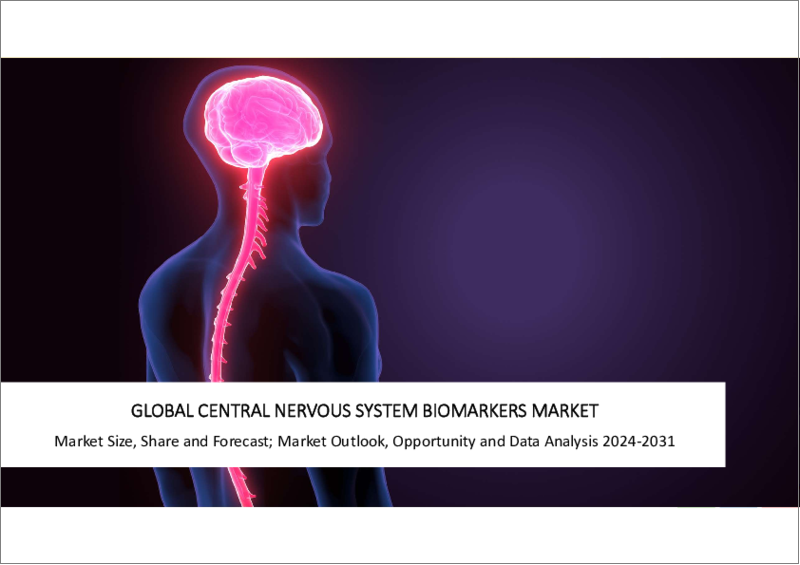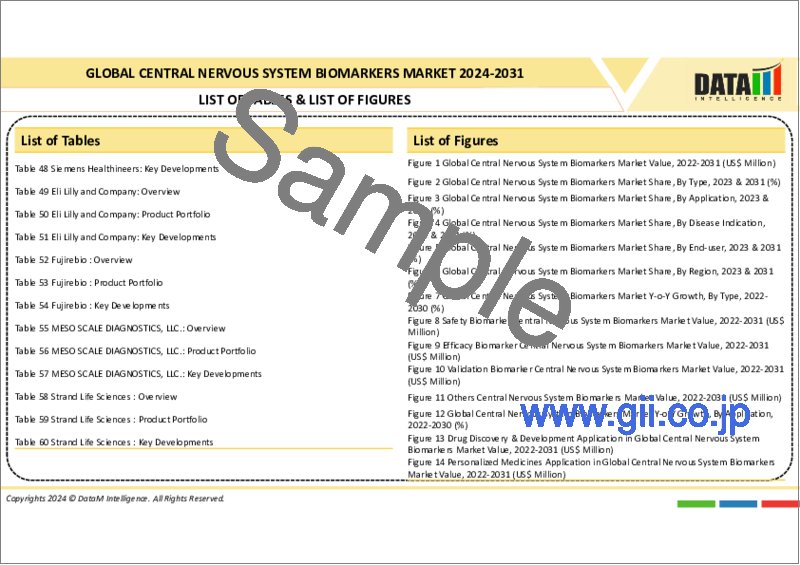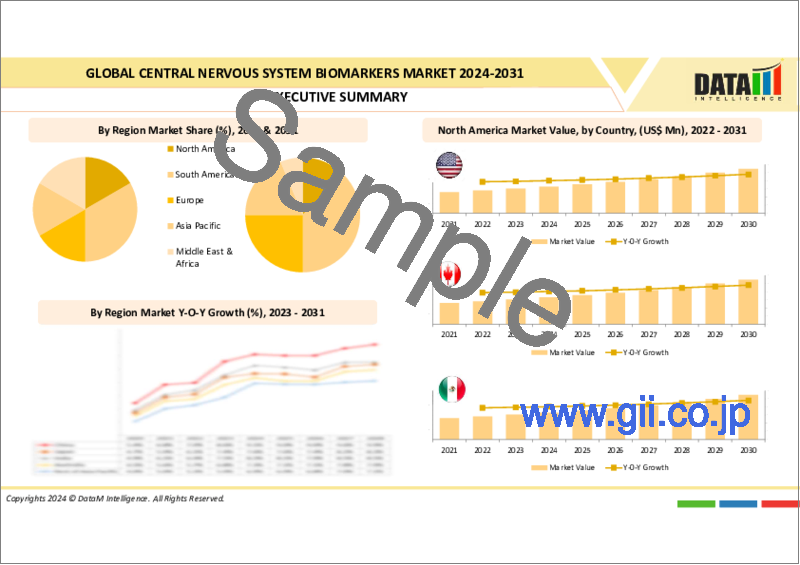|
|
市場調査レポート
商品コード
1289774
中枢神経系バイオマーカーの世界市場-2023-2030Global Central Nervous System Biomarkers Market - 2023-2030 |
||||||
カスタマイズ可能
適宜更新あり
|
|||||||
| 中枢神経系バイオマーカーの世界市場-2023-2030 |
|
出版日: 2023年06月12日
発行: DataM Intelligence
ページ情報: 英文 195 Pages
納期: 即日から翌営業日
|
- 全表示
- 概要
- 目次
市場概要
中枢神経系バイオマーカーの世界市場規模は、2022年に47億9,080万米ドルに達し、2030年には最大98億5,270万米ドルに達することで有利な成長が予測されます。予測期間中(2023年~2030年)のCAGRは9.7%です。
バイオマーカーは、生物学的プロセス、疾患の状態、治療に対する反応に関する情報を提供する定量的な測定値です。バイオマーカーは、ある疾患の病因や病態をより深く理解する可能性があり、多くの衰弱した疾患や疾病の診断、治療、予後に関する貴重な知見を研究者や臨床医に提供するものです。
中枢神経系バイオマーカー市場は、中枢神経系組織、髄液、血液のプロテオミクス、ゲノミクス、メタボローム解析、イメージング技術の組み合わせ、新規バイオマーカーの開発などの要因によって牽引されています。
市場力学
新規バイオマーカーに対する需要の高まり
中枢神経系疾患の新規バイオマーカーとして、タウタンパク質、ニューロフィラメント軽鎖(NFL)、グリア線維性酸性タンパク質(GFAP)、ユビキチンC末端ヒドロラーゼL1(UCH-L1)などが考えられています。タウ蛋白は、主に中枢神経系の白質に存在する神経軸索マーカーであり、虚血性脳卒中や心停止で増加することが報告されています。NFLは心停止後の予後予測に高い精度を示しますが、アルツハイマー病などの神経変性疾患でも増加することが報告されています。
GFAPは、神経保護機構の一部として産生されるアストロサイトマーカーで、頭部外傷、脳内出血、虚血性脳卒中、心停止後の予後と関連します。UCH-L1は神経細胞体マーカーであり、脳損傷後の神経軸索の安定と修復に重要です。
技術の進歩により、バイオマーカーの発見ペースは上がっているが、そのほとんどはまだ検証されていないです。バイオマーカーを臨床試験や診療に取り入れることで、試験の効率が向上し、個別化神経学の進歩につながります。
中枢神経系バイオマーカーの検査と診断にかかる高いコスト
サンプル収集や保管などの検証プロセスにかかるコストが高いため、標準治療とみなされないバイオマーカーを介した治療には保険が適用されないことから、政府の規則や方針が変わりつつあります。
バイオマーカーが検査に大きな付加価値を与えても、払い戻しは限られています。例えば、5,000万人以上の受益者を抱える米国最大のヘルスケア保険会社であるメディケアは、実験的な医薬品やほとんどのスクリーニング検査およびバイオマーカー検査に資金を提供していません。したがって、上記の要因が予測期間中の市場成長の妨げになると予想されます。
COVID-19の影響分析
COVID-19パンデミックは、認知障害や神経変性変化を含むさまざまな神経学的合併症と関連しています。例えば、ウェストバージニア州のマーシャル大学は、COVID-19に関連する多様な神経変性変化を検討し、疾患の進行と重症度に関連する、主要な循環バイオマーカーの重要性を強調しました。
彼らの文献調査では、GFAP、NfL、pT181-tauなどの重要なCNSタンパク質や様々な炎症性サイトカインが、COVID-19患者において著しく変化していることが示されました。COVID-19に関連する神経病理学的変化や、重症化するリスクのある患者の特定にバイオマーカーを使用する可能性についての現在の理解は限られています。
ロシア・ウクライナ紛争分析
戦争が世界の科学界に与える長期的な影響と、ロシア・ウクライナ戦争中にウクライナの学術、医学、科学分野の研究の機会を逃したことに関するリスク。FDAの臨床試験データベースによると、ウクライナは251の医薬品とデバイスを試験していました。
臨床試験データベースによると、2022年にはウクライナで1,000以上の薬の臨床試験が進行中または計画されており、そのうち腫瘍の分野だけでも786件ありました。戦争により、ロシアの臨床試験実施施設では、リソースやマンパワーが優先順位に従って配分されず、中枢神経系ケアの悪化につながるなど、マイナスの影響が生じています。
目次
第1章 調査手法とスコープ
- 調査手法
- 調査目的および調査範囲
第2章 定義と概要
第3章 エグゼクティブサマリー
第4章 市場力学
- 影響要因
- 促進要因
- 新規バイオマーカーへの需要の高まり
- 抑制要因
- 中枢神経系バイオマーカー検査・診断の高コスト化
- 機会
- 影響分析
- 促進要因
第5章 産業分析
- ポーターの5フォース分析
- サプライチェーン分析
- 価格分析
- 法規制の分析
第6章 COVID-19の分析
第7章 タイプ別
- 安全性バイオマーカー
- 有効性バイオマーカー
- バリデーションバイオマーカー
- その他
第8章 アプリケーション別
- 創薬・医薬品開発
- 個別化医療
- 疾病リスクアセスメント
- 診断薬
- その他
第9章 疾患別
- 多発性硬化症
- アルツハイマー型認知症
- パーキンソン病
- 外傷性脳損傷
- その他
第10章 エンドユーザー別
- 診断ラボ
- 診療所
- 病院
- 研究機関
- その他
第11章 地域別
- 北米
- 米国
- カナダ
- メキシコ
- 欧州
- ドイツ
- 英国
- フランス
- イタリア
- スペイン
- その他欧州
- 南米
- ブラジル
- アルゼンチン
- その他南米地域
- アジア太平洋地域
- 中国
- インド
- 日本
- オーストラリア
- その他アジア太平洋地域
- 中東・アフリカ地域
第12章 競合情勢
- 競合シナリオ
- 市況/シェア分析
- M&A(合併・買収)分析
第13章 企業プロファイル
- Acumen Pharmaceuticals Inc.
- 会社概要
- 製品ポートフォリオと説明
- 財務概要
- 主な発展状況
- Biogen Inc.
- Alseres Pharmaceuticals Inc.
- Aposense Ltd.
- Avacta Life Sciences Ltd.
- Banyan Biomarkers Inc.
- Bio-Rad Laboratories Inc.
- DiaGenic ASA
- G-Biosciences
- Thermo Fisher Scientific Inc.
第14章 付録
Market Overview
The Global Central Nervous System Biomarkers Market size reached US$ 4,790.8 million in 2022 and is projected to witness lucrative growth by reaching up to US$ 9,852.7 million by 2030. The market is exhibiting at a CAGR of 9.7% during the forecast period (2023-2030).
Biomarkers or biological markers are quantitative measurements that provide information about biological processes, a disease state, or a response to treatment. They have the potential to better understand the etiology and pathogenesis of a given disorder, providing researchers and clinicians with valuable insight into diagnosis, treatment, and prognosis for many debilitating disorders and diseases.
The central nervous system biomarkers market is driven by factors such as combining proteomics, genomics, and metabolomic interrogation of CNS tissues, CSF, or blood, and imaging technologies and the development of novel biomarkers.
Market Dynamics
Increasing Demand For Novel Biomarkers
Novel potential biomarkers for CNS disorders include the tau protein, neurofilament light chain (NFL), glial fibrillary acidic protein (GFAP), and ubiquitin C-terminal hydrolase-L1 (UCH-L1). The tau protein is a neuroaxonal marker located mainly in the white matter of the central nervous system and is reported to be increased in ischemic stroke and cardiac arrest. The NFL is highly accurate in prognostication after cardiac arrest, but it has also been reported to increase in neurodegenerative disorders such as Alzheimer's disease.
GFAP is an astrocytic marker that is produced as part of a neuroprotective mechanism and has been associated with prognosis after head trauma, intracerebral hemorrhage, ischemic stroke, and cardiac arrest. UCH-L1 is a neuronal cell body marker that is crucial for neuroaxonal stability and repair after brain injury.
Technological advances have increased the pace of biomarker discovery, but most are yet to be validated. Incorporating biomarkers into clinical trials and practice will help improve study efficiency and inform advancements in personalized neurology.
High Cost of CNS Biomarker Testing and Diagnostics
With the high cost of the validation process, such as sample collection & storage, government rules and policies are changing since reimbursements do not cover biomarker-mediated therapies that are not considered standard of care.
Even though biomarkers add significant value to tests, refunds are limited. For instance, Medicare, the nation's largest healthcare insurer with more than 50 million beneficiaries, does not fund experimental medicines or most screening and biomarker tests. Therefore, the above factors are expected to hamper the market growth over the forecast period.
COVID-19 Impact Analysis
The COVID-19 pandemic has been linked to a range of neurological complications, including cognitive impairment and neurodegenerative changes. For instance, Marshall University, West Virginia, reviewed the diverse neurodegenerative changes associated with COVID-19 and highlighted the importance of major circulating biomarkers, associated with disease progression and severity.
Their literature survey indicated that important CNS proteins, such as GFAP, NfL, and pT181-tau, and various inflammatory cytokines, are altered significantly in COVID-19 patients. The current understanding of the neuropathological changes associated with COVID-19 and the potential use of biomarkers in identifying patients at risk for developing severe forms of the disease is limited.
Russia-Ukraine Conflict Analysis
Risk about the war's long-term impact on the scientific community worldwide and the missed opportunities for research in Ukraine's academic, medical, and scientific disciplines during Russia Ukraine war. Ukraine was testing 251 medicines and devices, according to the FDA's clinical trials database.
According to the clinical trials database, in 2022, over 1,000 medication clinical trials were underway or planned in Ukraine, including 786 in the field of oncology alone. The war has had a negative impact on Russian clinical trial sites, as resources and manpower are not allocated according to priority, leading to worsening CNS care.
Segment Analysis
The global central nervous system biomarkers market is segmented by type, application, disease, end-user, and by region.
Based on Type, Safety Biomarkers Segment Is Expected To Drive The Market Growth
The safety biomarkers segment accounted for the highest market stake accounting for approximately 35.5% of the central nervous system biomarkers market in 2022. Safety biomarkers are expected to dominate the market growth due to increased awareness of health issues such as depression, Parkinson's, and multiple sclerosis. They play a crucial role in preclinical and clinical research trials, with rapid changes in growth measurement, computation, and analysis leading to the explosive growth of the translational research field. For Instance, Donanemab improved cognition and ability to perform activities of daily living in patients with early Alzheimer's disease at 76 weeks.
Geographical Analysis
The Rising CNS Cancer Cases And Increasing R&D Expenditure
North America is estimated to hold around 42.7% of the total market share throughout the forecast period due to rising CNS cancer cases and increased R&D expenditure. According to the American Cancer Society, brain malignancy is the second most common cancer in children and adolescents, where CNS biomarkers are commonly used.
Competitive Landscape
The major global players in the market include: Acumen Pharmaceuticals, Biogen, Alseres Pharmaceuticals, Aposense, Avacta Life Sciences Ltd., Banyan Biomarkers Inc., Bio-Rad Laboratories Inc., DiaGenic ASA, G-Biosciences, and Thermo Fisher Scientific.
Why Purchase the Report?
- To visualize the global central nervous system biomarkers market segmentation based on type, application, disease, end-user, and region and understand key commercial assets and players.
- Identify commercial opportunities by analyzing trends and co-development.
- Excel data sheet with numerous data points of central nervous system biomarkers market-level with all segments.
- PDF report consists of a comprehensive analysis after exhaustive qualitative interviews and an in-depth study.
- Product mapping available as Excel consisting of key products of all the major players.
The global central nervous system biomarkers market report would provide approximately 54 tables, 46 figures, and 195 pages.
Target Audience 2023
- Manufacturers/ Buyers
- Industry Investors/Investment Bankers
- Research Professionals
- Emerging Companies
Table of Contents
1. Methodology and Scope
- 1.1. Research Methodology
- 1.2. Research Objective and Scope of the Report
2. Definition and Overview
3. Executive Summary
- 3.1. Snippet by Type
- 3.2. Snippet by Application
- 3.3. Snippet by Disease
- 3.4. Snippet by End-User
- 3.5. Snippet by Region
4. Dynamics
- 4.1. Impacting Factors
- 4.1.1. Drivers
- 4.1.1.1. Increasing demand for Novel Biomarkers
- 4.1.2. Restraints
- 4.1.2.1. High Cost of CNS Biomarker Testing and Diagnostics
- 4.1.3. Opportunity
- 4.1.4. Impact Analysis
- 4.1.1. Drivers
5. Industry Analysis
- 5.1. Porter's 5 Forces Analysis
- 5.2. Supply Chain Analysis
- 5.3. Pricing Analysis
- 5.4. Regulatory Analysis
6. COVID-19 Analysis
- 6.1. Analysis of COVID-19
- 6.1.1. Scenario Before COVID-19
- 6.1.2. Scenario During COVID-19
- 6.1.3. Scenario Post COVID-19
- 6.2. Pricing Dynamics Amid COVID-19
- 6.3. Demand-Supply Spectrum
- 6.4. Government Initiatives Related to the Market During the Pandemic
- 6.5. Manufacturer's Strategic Initiatives
- 6.6. Conclusion
7. By Type
- 7.1. Introduction
- 7.1.1. Market Size Analysis and Y-o-Y Growth Analysis (%), By Type
- 7.1.2. Market Attractiveness Index, By Type
- 7.2. Safety Biomarkers*
- 7.2.1. Introduction
- 7.2.2. Market Size Analysis and Y-o-Y Growth Analysis (%)
- 7.3. Efficacy Biomarkers
- 7.4. Validation Biomarkers
- 7.5. Others
8. By Application
- 8.1. Introduction
- 8.1.1. Market Size Analysis and Y-o-Y Growth Analysis (%), By Application
- 8.1.2. Market Attractiveness Index, By Application
- 8.2. Drug Discovery & Development*
- 8.2.1. Introduction
- 8.2.2. Market Size Analysis and Y-o-Y Growth Analysis (%)
- 8.3. Personalized Medicines
- 8.4. Disease Risk Assessment
- 8.5. Diagnostics
- 8.6. Others
9. By Disease
- 9.1. Introduction
- 9.1.1. Market Size Analysis and Y-o-Y Growth Analysis (%), By Disease
- 9.1.2. Market Attractiveness Index, By Disease
- 9.2. Multiple Sclerosis*
- 9.3. Alzheimer's Disease
- 9.4. Parkinson's Disease
- 9.5. Traumatic Brain Injury
- 9.6. Others
10. By End-User
- 10.1. Introduction
- 10.1.1. Market Size Analysis and Y-o-Y Growth Analysis (%), By End-User
- 10.1.2. Market Attractiveness Index, By End-User
- 10.2. Diagnostic Labs
- 10.3. Clinics
- 10.4. Hospitals
- 10.5. Research Centers
- 10.6. Others
11. By Region
- 11.1. Introduction
- 11.1.1. Market Size Analysis and Y-o-Y Growth Analysis (%), By Region
- 11.1.2. Market Attractiveness Index, By Region
- 11.2. North America
- 11.2.1. Introduction
- 11.2.2. Key Region-Specific Dynamics
- 11.2.3. Market Size Analysis and Y-o-Y Growth Analysis (%), By Type
- 11.2.4. Market Size Analysis and Y-o-Y Growth Analysis (%), By Application
- 11.2.5. Market Size Analysis and Y-o-Y Growth Analysis (%), By Disease
- 11.2.6. Market Size Analysis and Y-o-Y Growth Analysis (%), By End-User
- 11.2.7. Market Size Analysis and Y-o-Y Growth Analysis (%), By Country
- 11.2.7.1. The U.S.
- 11.2.7.2. Canada
- 11.2.7.3. Mexico
- 11.3. Europe
- 11.3.1. Introduction
- 11.3.2. Key Region-Specific Dynamics
- 11.3.3. Market Size Analysis and Y-o-Y Growth Analysis (%), By Type
- 11.3.4. Market Size Analysis and Y-o-Y Growth Analysis (%), By Application
- 11.3.5. Market Size Analysis and Y-o-Y Growth Analysis (%), By Disease
- 11.3.6. Market Size Analysis and Y-o-Y Growth Analysis (%), By End-User
- 11.3.7. Market Size Analysis and Y-o-Y Growth Analysis (%), By Country
- 11.3.7.1. Germany
- 11.3.7.2. The U.K.
- 11.3.7.3. France
- 11.3.7.4. Italy
- 11.3.7.5. Spain
- 11.3.7.6. Rest of Europe
- 11.4. South America
- 11.4.1. Introduction
- 11.4.2. Key Region-Specific Dynamics
- 11.4.3. Market Size Analysis and Y-o-Y Growth Analysis (%), By Type
- 11.4.4. Market Size Analysis and Y-o-Y Growth Analysis (%), By Application
- 11.4.5. Market Size Analysis and Y-o-Y Growth Analysis (%), By Disease
- 11.4.6. Market Size Analysis and Y-o-Y Growth Analysis (%), By End-User
- 11.4.7. Market Size Analysis and Y-o-Y Growth Analysis (%), By Country
- 11.4.7.1. Brazil
- 11.4.7.2. Argentina
- 11.4.7.3. Rest of South America
- 11.5. Asia-Pacific
- 11.5.1. Introduction
- 11.5.2. Key Region-Specific Dynamics
- 11.5.3. Market Size Analysis and Y-o-Y Growth Analysis (%), By Type
- 11.5.4. Market Size Analysis and Y-o-Y Growth Analysis (%), By Application
- 11.5.5. Market Size Analysis and Y-o-Y Growth Analysis (%), By Disease
- 11.5.6. Market Size Analysis and Y-o-Y Growth Analysis (%), By End-User
- 11.5.7. Market Size Analysis and Y-o-Y Growth Analysis (%), By Country
- 11.5.8. China
- 11.5.9. India
- 11.5.10. Japan
- 11.5.11. Australia
- 11.5.12. Rest of Asia-Pacific
- 11.6. Middle East and Africa
- 11.6.1. Introduction
- 11.6.2. Key Region-Specific Dynamics
- 11.6.3. Market Size Analysis and Y-o-Y Growth Analysis (%), By Type
- 11.6.4. Market Size Analysis and Y-o-Y Growth Analysis (%), By Application
- 11.6.5. Market Size Analysis and Y-o-Y Growth Analysis (%), By Disease
- 11.6.6. Market Size Analysis and Y-o-Y Growth Analysis (%), By End-User
12. Competitive Landscape
- 12.1. Competitive Scenario
- 12.2. Market Positioning/Share Analysis
- 12.3. Mergers and Acquisitions Analysis
13. Company Profiles
- 13.1. Acumen Pharmaceuticals Inc.*
- 13.1.1. Company Overview
- 13.1.2. Product Portfolio and Description
- 13.1.3. Financial Overview
- 13.1.4. Key Developments
- 13.2. Biogen Inc.
- 13.3. Alseres Pharmaceuticals Inc.
- 13.4. Aposense Ltd.
- 13.5. Avacta Life Sciences Ltd.
- 13.6. Banyan Biomarkers Inc.
- 13.7. Bio-Rad Laboratories Inc.
- 13.8. DiaGenic ASA
- 13.9. G-Biosciences
- 13.10. Thermo Fisher Scientific Inc.
LIST NOT EXHAUSTIVE
14. Appendix
- 14.1. About Us and Services
- 14.2. Contact Us





